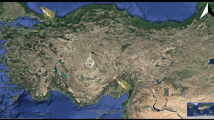Abstract
Habitat conditions drive the growth rate and the age structure of near-threatened species of Caucasian parsley frog (Pelodytes caucasicus). We studied the age structure and the growth parameters of the Caucasian parsley frogs obtained from four regions of Anatolia, that is, Giresun, Trabzon, Rize, and Artvin. Our results revealed a lower growth rate among the frogs residing in anthropogenic areas (Cımbırtlık, Giresun; Çat, Rize) compared to those living in the conservative areas (Hıdırnebi, Trabzon; Karagöl, Artvin). Also, the lowest values for age structure and the snout-vent length (SVL) were found in anthropogenic areas. Since P. caucasicus is categorized as “Near-Threatened” by the International Union for Conservation of Nature (IUCN) and the Red Data Books of some countries, we must manage protected areas and plan future conservation action for this species.



Similar content being viewed by others
REFERENCES
Altunışık, A. and Özdemir, N., Life history traits in Bufotes variabilis (Pallas, 1769) from 2 different altitudes in Turkey, Turk. J. Zool., 2015, vol. 39, no. 1, pp. 153–159.
Bronikowski, A.M., Experimental evidence for the adaptive evolution of growth rate in the garter snake Thamnophis elegans, Evolution, 2000, vol. 54, pp. 1760–1767.
Bülbül, U., Koç, H., Odabaş, Y., Eroğlu, A. I., Kurnaz, M., and Kutrup, B., Life history traits in a population of Pelobates syriacus (Boettger, 1889) from Turkey, Russ. J. Herpetol., 2020, vol. 27, no. 4, pp. 195–200.
Castanet, J. and Smirina, E., Introduction to the skeletochronological method in amphibians and reptiles, Ann. Sci. Nat. Zool. Biol. Anim., 1990, vol. 11, no. 4, pp. 191–196.
Chubinishvili, A.T., Gokhelashvili, R.K., and Tarkhnishvili, D.N., Population ecology of the Caucasian parsley frog (Pelodytes caucasicus Boulenger) in the Borjomi Canyon, Russ. J. Herpetol., 1995, vol. 2, no. 2, pp. 79–86.
Cogălniceanu, D., Băncilă, R.I., Plăiaşu, R., Roşioru, D., and Merilä, J., Small-scale spatial and temporal variation of life-history traits of common frogs (Rana temporaria) in sub-Arctic Finland, Polar Biol., 2017, vol. 40, no. 8, pp. 1581–1592.
Dubey, S., Sinsch, U., Dehling, M.J., Chevalley, M., and Shine, R., Population demography of an endangered lizard, the Blue Mountains Water Skink, BMC Ecol., 2013, vol. 13, no. 1, pp. 1–9.
Ergül Kalaycı, T. and Gümüşsoy, K., Genetic diversity of the Caucasian Parsley Frog, Pelodytes caucasicus (Anura: Pelodytidae), Zool. Middle East, 2022, pp. 1–7.
Erişmiş, U.C., Arıkan, H., Konuk, M., and Guarino, F.M., Age structure and growth in Caucasian parsley frog Pelodytes caucasicus (Boulenger, 1896) from Turkey, Russ. J. Herpetol., 2009, vol. 16, no. 1, pp. 19–26.
Esteban, M., Sánchez-Herráiz, M.J., Barbadillo, L.J., Castanet, J., and Márquez, R., Effects of age, size and temperature on the advertisement calls of two Spanish populations of Pelodytes punctatus, Amphib.–Reptil., 2002, vol. 23, no. 3, pp. 249–258.
Esteban, M., Sánchez-Herráiz, M.J., Barbadillo, L.J., and Castanet, J., Age structure and growth in an isolated population of Pelodytes punctatus in northern Spain, J. Nat. Hist., 2004, vol. 38, no.21, pp. 2789–2801.
Franzen, M., Verbreitung und Ökologie von Pelodytes caucasicus Boulenger, 1896 in der Türkei (Distribution and Ecology of Pelodytes caucasicus Boulenger, 1896 in Turkey), Salamandra, 1999, vol. 35, pp. 1–18.
Gokhelashvili, R. and Tarkhnishvili, D., Age structure of six Georgian anuran populations and its dynamics during two consecutive years, Herpetozoa, 1994, vol. 7, nos. 1/2, pp. 11–18.
Hamer, A.J. and McDonnell, M.J., Amphibian ecology and conservation in the urbanising world: a review, Biol. Conserv., 2008, vol. 141, no. 10, pp. 2432–2449.
Henderson, P.A. and Seaby, R.M., Growth II, Pisces Conservation Ltd., Lymington, England, 2006.
Kaya, U., Tuniyev, B., Tuniyev, S., Kuzmin, S., Tarkhnishvili, D., Tuniyev, B., Papaenfuss, T., Sparreboom, M., Ugurtas, I., Anderson, S., Eken, G., Kiliç, T., and Gem, E., Pelodytes caucasicus, The IUCN Red List of Threatened Species 2009, 2009, e.T39422A10236383. Downloaded February 14, 2020.
Litvinchuk, S.N. and Kidov, A.A., Distribution and conservation status of the Caucasian parsley frog, Pelodytes caucasicus (Amphibia: Anura), Nat. Conserv. Res., 2018, vol. 3, suppl. 1, pp. 51–60.
Marín-Moratalla, N., Jordana, X., and Köhler, M., Bone histology as an approach to providing data on certain key life history traits in mammals: implications for conservation biology, Mamm. Biol., 2013, vol. 78, no. 6, pp. 422–429.
Pough, F.H., The advantages of ectothermy for tetrapods, Am. Nat., 1980, vol. 115, pp. 92–112.
Robson, D.S. and Chapman, D.G., Catch curves and mortality rates, Trans. Am. Fish. Soc., 1961, vol. 90, no. 2, pp. 181–189.
Tosunoğlu, M. and Taşkavak, E., A preliminary study on morphology and serology of Pelodytes caucasicus Boulenger 1896 populations from North-Eastern Turkey, Pak. J. Biol. Sci., 2004, vol. 7, no. 7, pp. 1186–1190.
Veysey Powell, J.S. and Babbitt, K.J., Despite buffers, experimental forest clearcuts impact amphibian body size and biomass, PLoS One, 2015, vol. 10, no. 11, p. e0143505.
Zamudio, K.R., Bell, R.C., and Mason, N.A., Phenotypes in phylogeography: species’ traits, environmental variation, and vertebrate diversification, Proc. Natl. Acad. Sci. U.S.A., 2016, vol. 113, no. 29, pp. 8041–8048.
ACKNOWLEDGMENTS
We are thankful to Çiğdem Gül and Rahşan Evren Mazlum for their contribution to this study.
Funding
This research was funded by grant FYL-2020-1076 project from Recep Tayyip Erdoğan University.
Author information
Authors and Affiliations
Corresponding author
Ethics declarations
Conflict of interest. The authors declare that they have no conflicts of interest.Statement on the welfare of animals. The sampling was carried out with the permission of the local ethics committee for animal experiments (approval reference no. 2019/09-08).
Rights and permissions
About this article
Cite this article
Ergül Kalaycı, T., Gümüşsoy, K. Age Structure, Growth, and Body Size of Pelodytes caucasicus from Turkey. Biol Bull Russ Acad Sci 49 (Suppl 1), S124–S129 (2022). https://doi.org/10.1134/S1062359022130088
Received:
Revised:
Accepted:
Published:
Issue Date:
DOI: https://doi.org/10.1134/S1062359022130088




